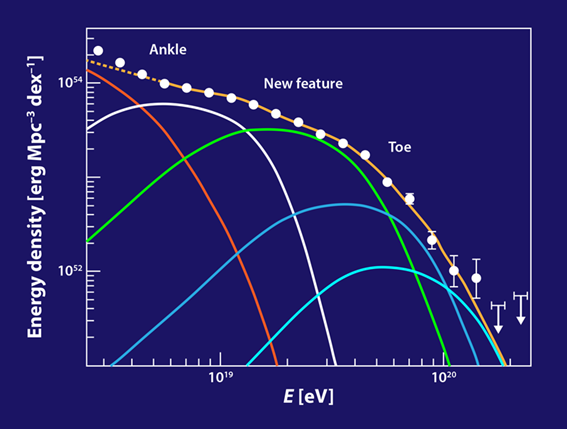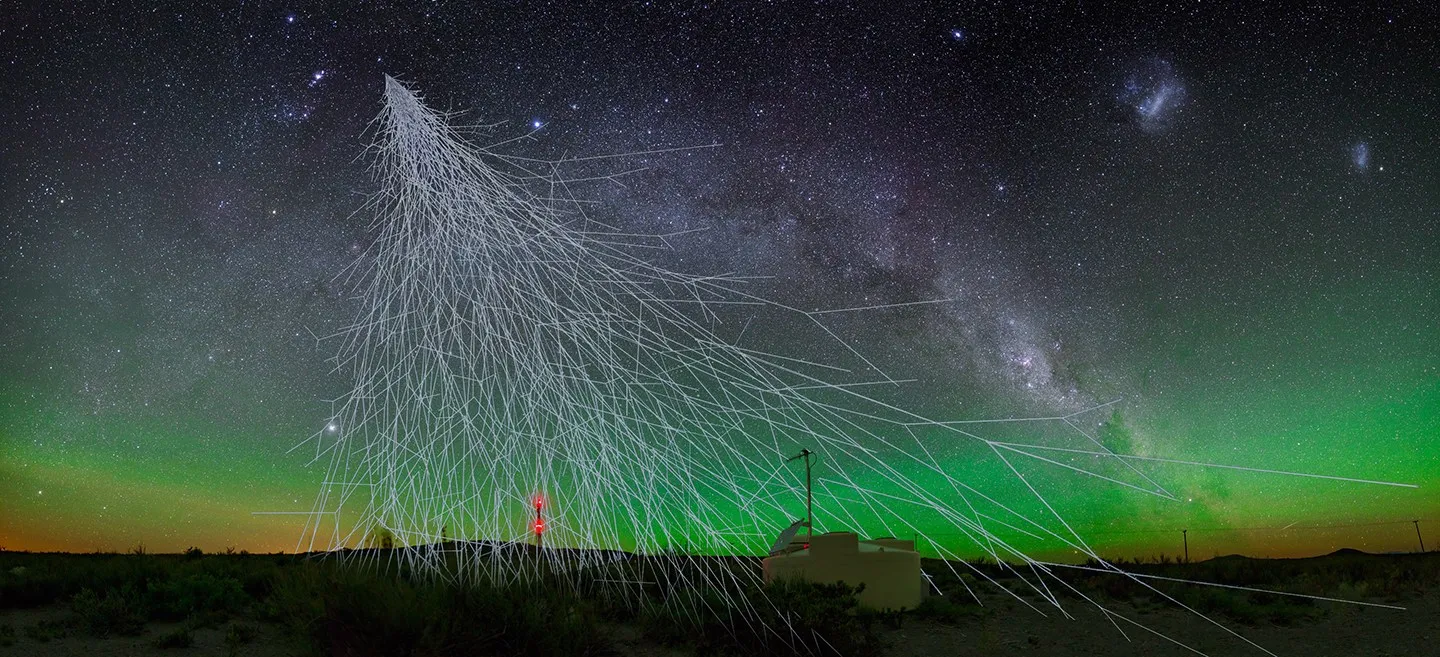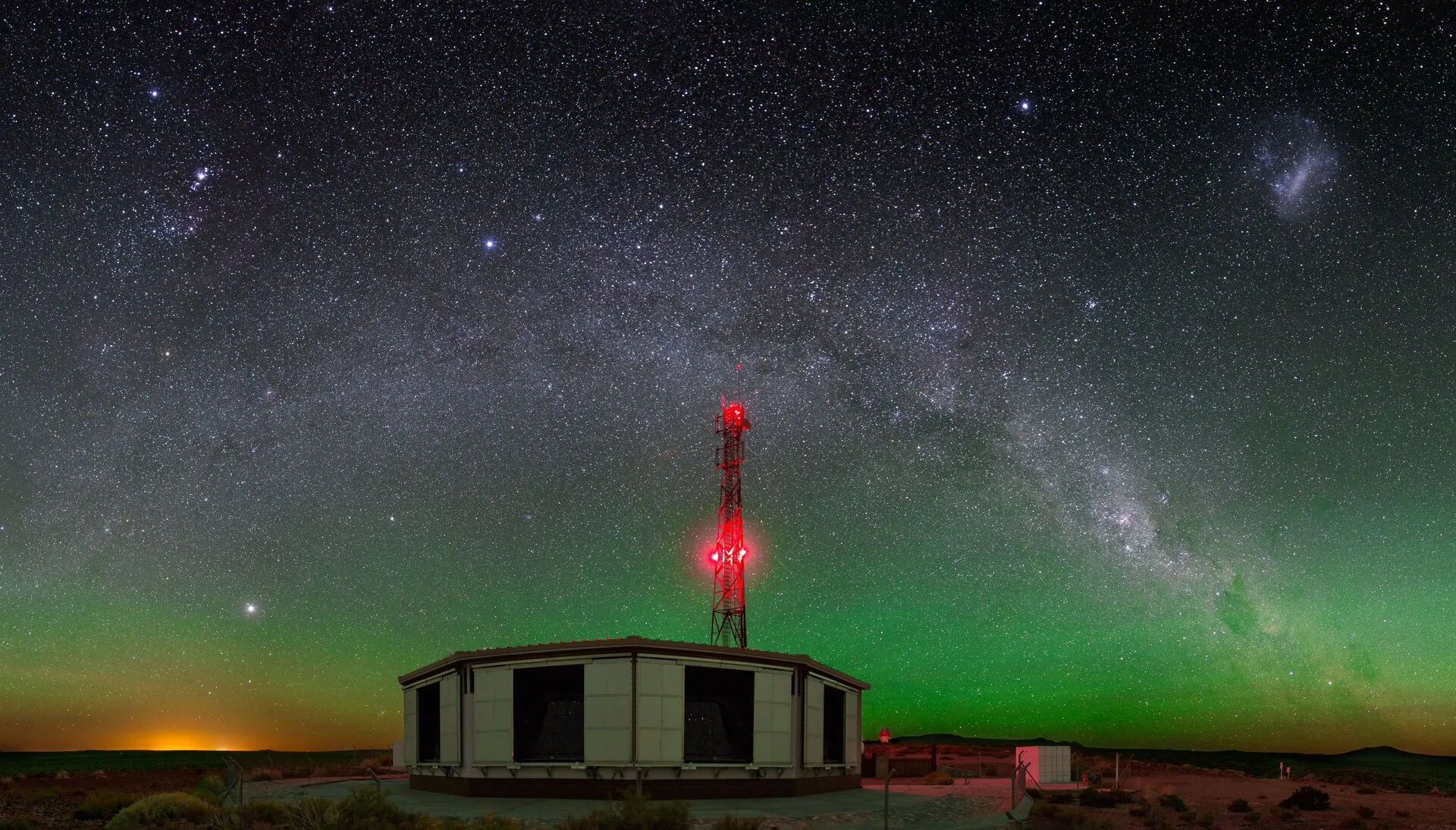A Colaboración do Observatorio Pierre Auger, na que o IGFAE lidera a participación española, presenta as medidas máis precisas ata a data sobre as partículas máis enerxéticas e enigmáticas do Universo que axudarían a esclarecer de onde proveñen.
Os raios cósmicos de ultra-alta enerxía (UHECR, polas súas siglas en inglés) son as partículas procedentes do espazo exterior máis enerxéticas do Universo (ata mais de 1020 eV). Se quixésemos acelerar unha partícula para alcanzar esa enerxía coa tecnoloxía dispoñible actualmente, habería que escalar o Gran Colisor de Hadróns (LHC) do CERN ao tamaño da órbita de Mercurio. A pesar de ser descubertos en 1961, aínda non sei sabe con exactitude como se producen e as fontes que os orixinan. Agora, novos datos da Colaboración Pierre Auger, na que participa o Instituto Galego de Físicade Altas Enerías (IGFAE), centro mixto da Universidade de Santiago (USC) e a Xunta de Galicia, revelan cunha precisión sen precedentes unha característica nova no espectro de enerxía destes raios cósmicos e reforza a hipótese de que a súa orixe está en galaxias con alta formación estelar (starbust galaxies) ou núcleos activos de galaxias (AGN). Os resultados publicáronse recentemente en Physical Review Letters e Physical Review D.
A Colaboración Pierre Auger é un grupo investigador de aproximadamente 400 persoas de 17 países que opera o observatorio de raios cósmicos máis grande do mundo en Malargüe, Mendoza (Arxentina). Está composto por máis de 1.600 tanques de auga con detectores Cherenkov repartidos nunha extensión de 3.000 km2 , unha superficie enorme xa que o fluxo destas partículas é tan escaso que cada mil anos chega á Terra menos dunha por quilómetro cadrado ás enerxías máis altas. Observan un tipo de luz ‒radiación Cherenkov‒ producida pola auga cando “choivas” de partículas ou fervenzas producidas polos raios cósmicos atravésana. Estes detectores compleméntanse con 27 telescopios de fluorescencia que captan a luz ultravioleta causada polas fervenzas ao atravesar a atmosfera. Xuntos, proporcionan medicións da enerxía das fervenzas e medidas indirectas da masa da partícula primaria. Combinando a información sobre o espectro de enerxía, a composición da masa e a distribución da dirección de chegada, pódense deducir características importantes das posibles fontes que orixinan estas partículas extraordinarias.
Nos traballos publicados e que analizan os 215.000 eventos recompilados polo Observatorio Pierre Auger ata a data, observouse unha nova característica do espectro enerxético dos UHECR, que se reflicte nunha lixeira inclinación da curva ao redor dos 13 × 1018 eV. Ese suavizado nesta rexión intermedia (figura 1) podería ser consecuencia natural de que a composición de masa dos raios cósmicos cambia, en función da enerxía, de lixeira a pesada. Os resultados poden explicarse con fontes extragalácticas de raios cósmicos distribuídas de forma relativamente uniforme, que aceleran partículas a maior enerxía canto máis pesadas. Estes modelos requiren un espectro extremadamente duro ‒con máis cantidade de partículas de alta enerxía- e fontes practicamente constantes ao longo do tempo. Neste escenario, ambos os requisitos non concordan coas observacións de fontes luminosas próximas en todos os tipos de luz do espectro electromagnético, desde radioondas ata raios gamma.
Fervenzas inclinadas e enerxía invisible
O equipo do IGFAE, liderado polo profesor da USC Enrique Zas, participou na elaboración do artigo e liderou a análise de fervenzas ou choivas de partículas inclinadas, que se utilizou para o establecemento da chamada “enerxía invisible”, fundamental para a determinación precisa da enerxía.
España contribuíu notablemente á Colaboración Pierre Auger en aspectos moi diversos: análise de choivas inclinadas, contido de muóns das fervenzas, natureza das partículas primarias, aplicacións de técnicas de aprendizaxe automática, procura de neutrinos, astronomía de multimensaxeiros, técnica de fluorescencia e técnica de radio. Actualmente no proxecto participan a Universidad de Granada e o IGFAE, que liderou a participación española desde a súa orixe na década de 1990.

Figura 1. O espectro dos UHECR composto a partir dos últimos datos de Auger en termos de densidade de enerxía. As observacións revelan unha nova característica a 13 × 1018 eV, onde o espectro inclínase lixeiramente. Esta ruptura no axuste da lei de potencia ocorre entre outras dúas rupturas: o “nocello” (ankle) e o “dedo do pé” (toe). A forma do espectro suxire que diferentes núcleos (mostrados en cores) contribúen a diferentes enerxías. Crédito: APS/Alan Stonebraker, adaptado de Phys. Rev. Lett. 125, 121106 (2020).
O Observatorio Pierre Auger atópase actualmente nunha actualización a gran escala, instalando detectores de escintilación e antenas de radio na parte superior das estacións detectoras de auga. Isto permitirá obter máis información sobre a composición da masa dos raios cósmicos de ultra-alta enerxía, estendéndoa a enerxías máis altas onde unha posible presenza de núcleos de masa lixeira podería abrir unha nova xanela a procuras sensibles á composición de fontes e estudos de campos magnéticos cósmicos.
Referencias:
Aab et al.(Pierre Auger Collaboration), “Features of the energy spectrum of cosmic rays above 2.5×1018eV using the Pierre Auger Observatory,” Phys. Rev. Lett. 125, 121106 (2020). DOI: https://doi.org/10.1103/PhysRevLett.125.121106
Aab et al.(Pierre Auger Collaboration), “Measurement of the cosmic-ray energy spectrum above 2.5 × 1018 eV using the Pierre Auger Observatory,” Phys. Rev. D 102, 062005 (2020). DOI: https://doi.org/10.1103/PhysRevD.102.062005






